Looking at different greyhound collars
Options to consider if a greyhound collar alone is not giving you good control of your greyhound. The following article is based on my own personal experience of exercising my own four pet greyhounds and a variety of very different and then unadopted/unsocialised greyhounds over the past few years. Comments made are my opinions only, applying to control aids that I have used personally. There may be other options available that are, as yet un-tested by myself, but which also work well.
by Marie Harris – Greyhound Lifeline
Please note that the majority of greyhounds are well mannered on a lead and require nothing more than a greyhound collar (plus muzzle until your greyhound is 100% reliable) to walk them safely and easily.
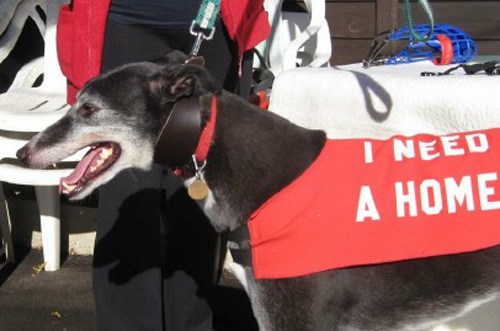
There are a few greyhounds however that it is not so easy to maintain control of. Perhaps they are consistently strong, perhaps they are unpredictable or perhaps your greyhound is a fearful one that when frightened by something can become a “Houdini” style escape artist.
Even a nicely mannered greyhound can change from being a “dream on a lead” into a contestant for Mr Universe crossed with a circus acrobat if he/she sights a squirrel or cat for example. If your greyhound has any of the above problems or reactions then this page could help you find an aid to control that suits you. Please note that all the suggestions below work well in conjunction with a greyhound muzzle and can be used either on their own or in conjunction with a greyhound collar.
Halti
Halti without a muzzle
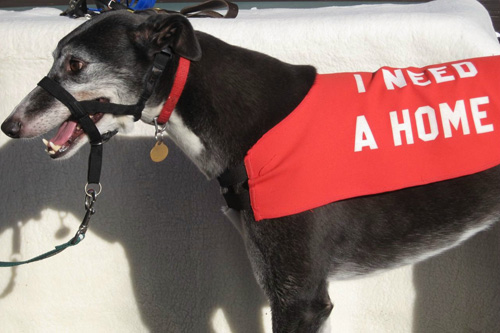
Halti with a muzzle
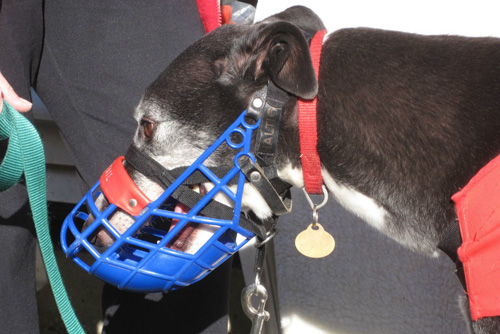
A Halti is similar to a horses head collar, but designed specifically to fit a dog’s head. A size 2 is a good fit for most greyhounds. Once fitted correctly, I would personally recommend stitching the webbing to prevent the adjustment sliders moving over time.
Positive points of a Halti collar:
:: A kind method of control.
:: Excellent for a strong greyhound, a Halti reduces physical effort on your part considerably and makes it easy to control the direction of your dog. A Halti also minimises strain on any part of the greyhound’s body.
:: Gives excellent head control enabling you to prevent pouncing on un-suspecting sleeping cats in hedges etc.
:: Can be used with a greyhound collar or alone (once you are familiar with your dog’s reactions). If using a Halti with a collar you will either require 2 leads (the shorter on on the Halti and the longer one as a back up on the collar) or you could adapt a “couple” (designed to walk two dogs on one lead) by shortening the Halti end slightly. An adapted couple will allow you to utilise just one lead, but retain two forms of control.
:: Readily accepted by most greyhounds. The nose band of the Halti rests around the dog’s nose and likely feels similar to a muzzle which greyhounds are generally accustomed to wearing.
:: Easy to obtain either from your local pet shop or from internet suppliers.
Negative points of a Halti collar:
:: Not suitable for sole use on “head shakers”, fearful greyhounds or those who tend to back away. These types of dog can escape from a Halti.
Greyhound Harness
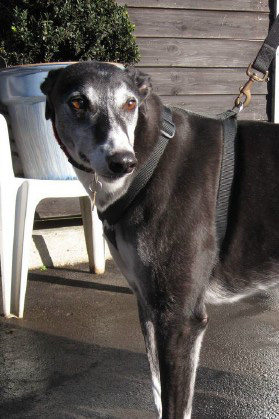
A body harness can in my opinion be very useful to prevent neck injuries from pulling or jerking or on a greyhound who has previously suffered a neck or spinal injury although if this type of injury is known about I would suggest seeking the advice of your vet for a suitable method of walking out in the first instance. There are many different styles of harness available for greyhounds.
Positive points of a greyhound harness:
:: A kind method of control.
:: Good as a secondary method of control for the acrobatic dog, or a sole method for a well behaved dog.
:: Gives good control of the dog’s body.
:: Readily accepted by most greyhounds. Most don’t react at all to wearing a harness, a few are obviously comforted by the feeling of being “hugged” that a harness can offer.
:: If you have purchased the car seat belt variety of harness, it will have the dual purpose of preventing your greyhound becoming a 30kg missile in the event of a motoring accident and it is also ideal for people wanting their greyhound to travel safely when a fixed dog guard or cage is not available.
:: Easily obtained from many pet shops or online suppliers.
Negative points of a greyhound harness:
:: Not suitable for sole use on a determined “escape artist”. To date, I have been unable to find a harness that is 100% escape proof, although for the majority of normal greyhounds a harness would be sufficient.
:: Can rub a greyhound’s sensitive skin if not sufficiently soft or padded.
:: Roughly 2% of the greyhounds that I have walked out, refuse flat to walk anywhere wearing a harness.
:: A harness offers no control of your dog’s head.
Greyhound Canny Collar
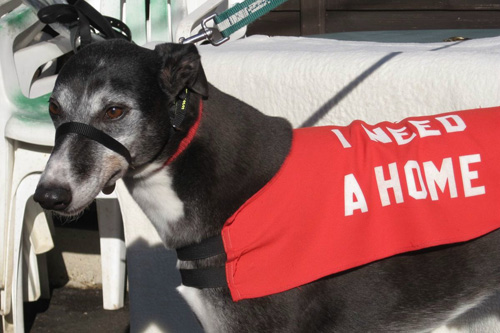
A Canny Collar is a neck collar fitted with an adjustable additional band that fits around the greyhound’s nose and tightens when pulled. A size 2 will fit most greyhounds. A size 3 will be too big for all but the very largest of greyhounds.
Important note – correct fitting of a Canny Collar is essential in order for the collar to do what it was designed to do. The collar should be snugly fitted just behind the greyhound’s ears with room for just two fingers to be comfortably inserted between the collar and the dog’s neck. Too loose and the dog may manage to slip out of it and too tight your dog could be gasping for air!
Positive points of a Canny Collar:
:: A kind method of control.
:: Excellent as the only form of control on all greyhounds or in addition to other methods if you prefer.
:: Gives excellent head control.
:: Ideal on a strong, fearful or acrobatic dogs.
:: Excellent for a strong dog, a Canny Collar reduces physical effort on your part considerably and makes it easy to control the direction of your dog. A Canny Collar also minimises strain on any part of the dog’s body.
:: Readily accepted by most greyhounds. The nose band of the Canny Collar rests around the dog’s nose and likely feels similar to a muzzle which greyhounds are generally accustomed to wearing.
:: Generally supplied with a 30 day money back guarantee, if you should not be pleased with the result.
Negative points of a Canny Collar:
:: Not easily obtained from pet shops, but a Canny Collar can be purchased from a selection of internet stockists and it often comes with a 30 day money back guarantee if you are not completely satisfied.
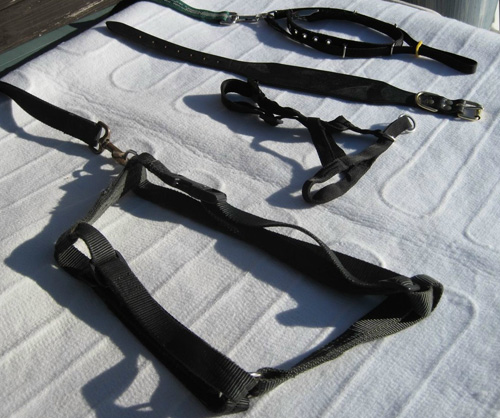
A Cautionary note:
Please never use a flexi or retractable/extending lead on a greyhound. These leads are highly dangerous for greyhounds regardless of whether they are attached to a collar, a harness, a Halti or a Canny Collar and I believe this for the following reasons::
Please remember the speed capability of a greyhound 0-40mph+ in around 3 seconds! By the time you have reacted to your greyhound “taking off”, he/she has reached the end of the extending lead which could result in one of several possibilities:
:: Your greyhound could break it’s neck by coming to an abrupt stop by neck pressure alone. Your greyhound could also injure its neck or back as a direct result of the jarring caused by the abrupt stop.
:: You could suffer shoulder injury and lose your grip on the lead resulting in a trip to A & E, after of course you have once again found your greyhound and perhaps already taken him to the vet.
:: An extending lead case is held only by your fingers, you cannot wrap the case around your wrist as extra security against dropping it. A loose dog with extending lead attached could get caught on just about any obstruction and your greyhound could severely damage any part of his/her body trying to escape the “cheese wire” style lead wrapped around him.
:: Your greyhound could literally “run his/her heart out” trying to escape from the noisy and frightening bouncing thing that is clattering along behind him (the extending lead handle). Exhaustion, collapse and/or bleeding paws are a distinct possibility and that is not even allowing for the mental condition of the poor greyhound who has been utterly terrorised.
:: An extendable lead and case doing 40mph attached to a panic struck greyhound could do a tremendous amount of damage or injury to any persons, other animals or objects that are unfortunate enough to be whacked or lacerated by it as it speeds past.













